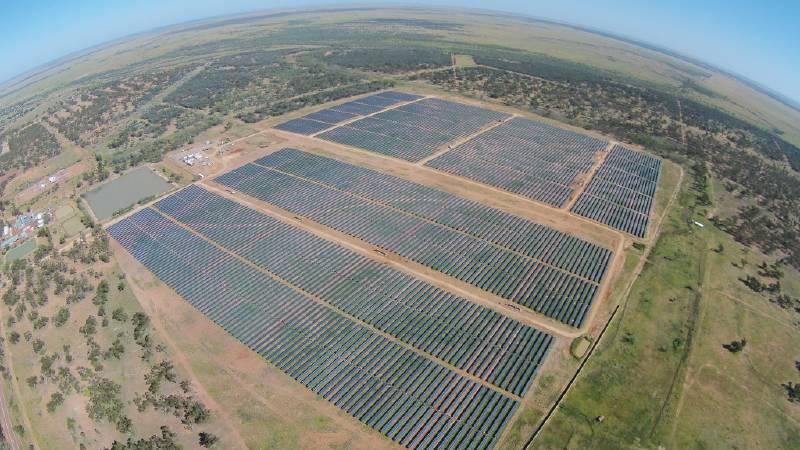Acetylene gas lighting began to take over from kerosene lamps in public buildings in the early 1900s and people found many uses for the lime residue of burnt-out carbide. It was used as a disinfectant for cesspits and stables, killed household pests, made effective whitewash and improved acid soil.
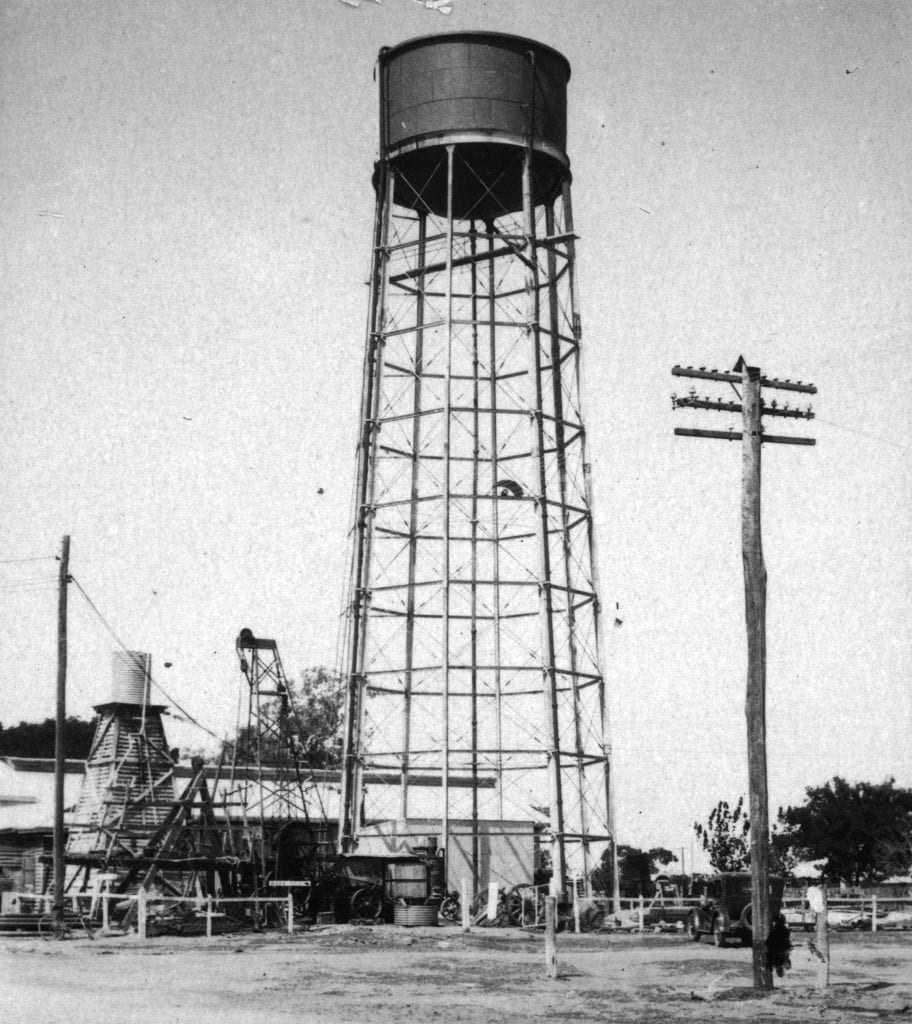
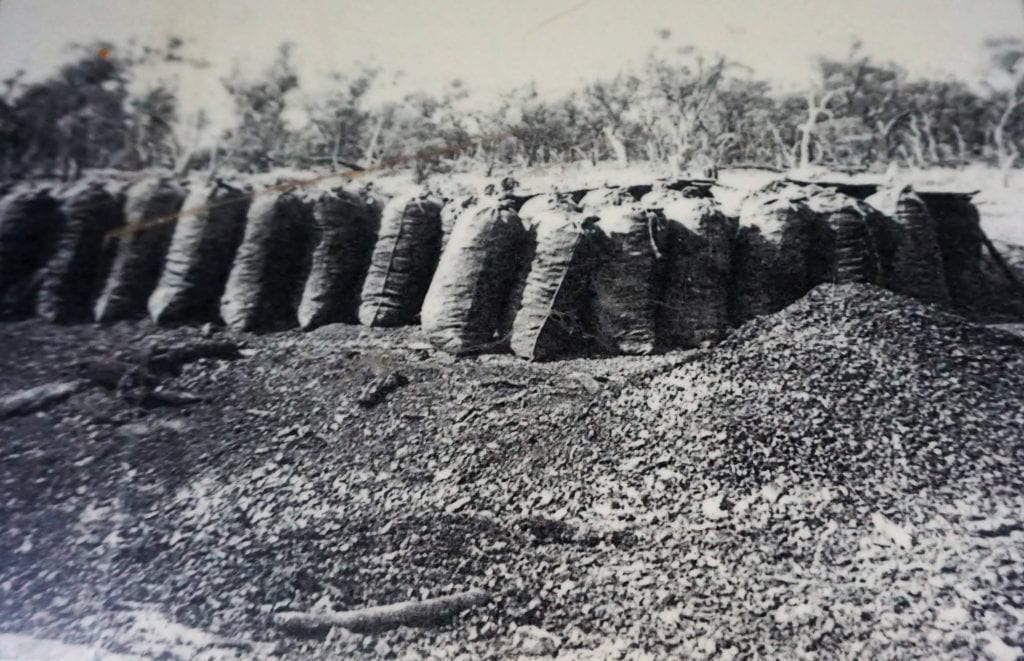
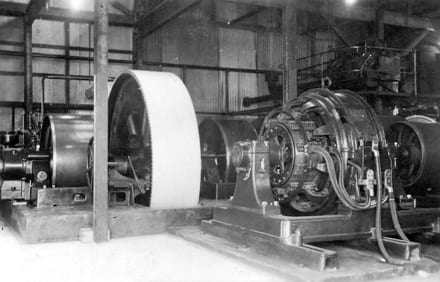
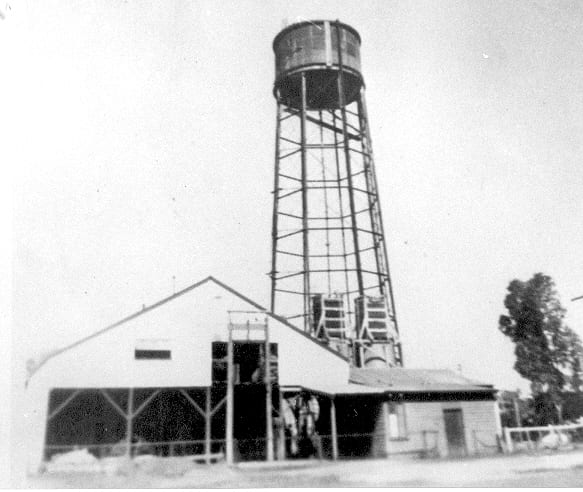
Electric Power
When the water tank and tower were erected, a second tank was set into the ground and the bore allowed to run into it. From this a Hawthorne Davey pump forced water through a 6 in. pipe to the tank on the tower. A shed was erected with room for an electric light plant. When first tested pressure was all that could be desired but the amount of water used horrified the councillors. Despite the water issues, the council pressed on with plans for electricity supply. A loan of £1,000 was arranged with the Queensland National Bank and Gordon Faine of Brisbane engaged to take charge of the project. On Queensland Day in August 1915, street lights were turned on for the first time. They burned from 7 to 11 pm at each intersection, and in a few places along the main streets. Once again Barcaldine had provided an amenity well ahead of other western towns.
The small engine soon proved inadequate and an attempt to borrow £5,000 for a larger one was rejected by ratepayers in 1916 so lights were often turned off during the war years and only a few public buildings could be supplied with electricity. But in 1918 a loan was negotiated, Engineer E. L. Wilson engaged, and a big Hornsby engine ordered.
On 24 February 1918, Tim Hannay returned from retirement near Rockhampton to declare Barcaldine power station open. The ceremony was marred by miserable rain and the big charcoal burning Hornsby had to be turned off before speakers could be heard, but it was a proud day in the town’s history. Afterwards street lights burned every night and electricity was available to all who could afford to install it. The achievement was even greater because it had been made despite delays and difficulties of the war years.
By 1927, improvement in the power supply involved purchase of a new engine. The council wanted another Hornsby, but despite support from local MLA, Frank Bulcock, it was forced by the government to accept a National. It was a 200 horse power British engine with a huge fly wheel and a wood burning gas producer. Wood was cheaper fuel than charcoal (used by the Hornsby) but not as effective, and having two different engines led to many troubles in the years that followed.
When the power and water scheme was complete, the plant could supply a town twice Barcaldine’s size but much of the population could not afford electricity so the council could not recoup its investment. In 1934 new electric light poles cost £2,500.
By 1939, when the second world war began, the power house’s equipment was outmoded. A second-class Crossley engine from Kyogle, chosen for Barcaldine by A. E. Axon, Consulting Engineer of Brisbane, proved to have a cracked bearing when installed. The old Hornsby and National engines were badly worn and the switchboard in need of reconstruction; but funds and machinery were hard to obtain and skilled manpower directed to the war effort. Matters at the power house reached a low ebb and remained so throughout the war. There were arguments, sackings and resignations. An idea of the problems can be gained from a council request to the engineer in 1943 to use more dignified terms in his reports, avoiding expressions like ‘leaping Lena’ and ‘going through the roof’.
In January 1950 a first loan of £62,000 was negotiated by the council for conversion from DC to AC power, a process that took five years. The land which had been used by McLaughlin’s wool scour was purchased as the site for a new power house. It had the advantage of a rail siding which would allow delivery of fuel without double handling. In 1950 an oil company was given permission to set up a bulk storage depot in the same area.
In 1952 after visits to Brisbane by Engineer R. Needham in January to discuss the conversion with State Electricity Commission authorities and by Shire Clerk D. E. Phipps in March, to iron out financial problems with the Treasury Department, the council received approval for installation of two National gas-cum-oil engines. By December, Needham and his assistants were working ’round the clock’ to install them at the old power house where they were used while the new site was being prepared.
The engines, with 150 kW and 110 kW alternators, could general 2,915 units, the most ever produced in Barcaldine. A third and larger engine with a 190 kW alternator was ordered for installation direct to the new site and in the first half of 1953 all public buildings were wired for AC current. By August, with the old DC engine battling to the last, the change-over began with buildings on the north side. By May 1954 the conversion was complete. In 1955 the new power house was constructed by Scotts of Ipswich and the third engine, a 5 cylinder 290 hp National was set in place. The remaining plant was transferred in 1956 and thereafter all generation was centralised at the new site.
The State Electricity Commission has suggested to the shire council that because of the financial position the council should defer certain sections of the proposed change - over scheme. With the new engines on hand the council will have to decide whether it is going to move the power house to a new site on the eastern edge of the town or remain in the present locality. If a move is decided upon then the new engines can be unloaded at the new site and erected to operate on oil until finance becomes available and the new power house built. An alternative would be to erect the engines at the old site, connected to the existing producers and run at cheaper costs. It was advised that the council is at present committed for £37,000 and it now awaits the return of the shire clerk (Mr D. R. Phipps) who is in Brisbane trying to arrange finance for the council. In a letter to the council. Mr F. K. Boustead, electrician, asked whether the council would meet the cost of change-over from direct to alternating current at the newly-constructed portion of the hospital, and stated that the wiring of that portion would be completed before the change- over was made. Councillors considered that the wiring at the hospital would not be complete before the commercial census of electrical appliances had been completed and therefore the council would not be responsible for the cost of the change-over. All appliances installed and shown on the census would be changed over at the council's cost, but the costs of anything installed after the census would have to be borne by the owner
Morning Bulletin, 25 March 1952
By 1960, the State Electricity Commission agreed to extend the generating capacity at Barcaldine by installation of a 250 kW plant which could supply the needs of Aramac. A 33 kW transmission line was completed in June 1961 and the plant at Aramac, which had been commissioned in 1952, was shut down and its engines transferred to other centres. By 1965 another generating set of 400 kW was transferred from Dalby to Barcaldine giving a total output of 1,100 kW and transmission was extended to Muttaburra in August of that year. Future plans involved extending power supply east to Alpha/Jericho and south to Blackall and Tambo. Barcaldine, the first central western town to provide electricity for its residents (in 1915) was set to become an electric authority for a wide area of the central district.
Relief from the cost of power supply came for council with the formation of the Central Western Regional Electricity Board (CWREB). Requests to bring power from the coast were made from Barcaldine in June 1964. Cr. W. R Chandler flew the Shire Chairman, J. Bennett and the Clerk, J. King to Brisbane to talk with State Electricity Commissioner, H. N. Smith. Barcaldine power house representative, R. Needham was also present. Needham managed the power station from just after the war when conditions were at the lowest ebb, through the change to AC current and until administration passed to CWREB. He died shortly after retirement in 1966. In June 1964 the Barcaldine representatives were told that power would ultimately be supplied by the State but that could not happen for many years and they should ‘go ahead as far as possible with power projects in their own interests’.
Other central western shires were experiencing power supply problems and increasing demand. In October 1964 Cr. L. Walker of Longreach Shire Council undertook an unofficial canvas in the area. This led to a conference convened by Longreach Chairman Walker, chaired by Cr. H. G. Behan, president of the Queensland and Western Local Authority Organisation, and attended by representatives of eight shires. From this meeting a formal request was made to H. N. Smith to speed provision of power to the west.
In March 1965 Smith visited Barcaldine for a conference. He suggested that all small centres cease operations and take power from two major centres of generation at Barcaldine and Longreach and that a Central Western Regional Electricity Board be formed to take over authority of the projects. he said that power from the coast could not be financed in the near future.
Afterwards Longreach councillors debated, loathe to surrender their autonomy and wary of Barcaldine’s geographically logical position as headquarters, but finally agreed to formation of a CWREB. On 9 May 1966 at an inaugural meeting of the eight shires (Barcaldine, Longreach, Blackall, Jericho, Isisford, Ilfracombe, Aramac and Tambo) the board came into existence with Cr. James Walker of Longreach as Chairman and Cr. James Bennett as deputy. Barcaldine was made the headquarters.
CWREB
In July 1966 a Rockhampton electrical engineer, R. W. Oxenham, was appointed manager of the enterprise. On 1 November 1966 CWREB took control of power supply for the central west, and after initial meetings in the Barcaldine Shire Hall, leased the RSL building as headquarters. In its first full year of operation (1967-68) the board expended $958,825 on electricity supply development. A 22k V transmission line to Blackall was commissioned in May 1968 and extended to Tambo in December. Another line to Jericho and Alpha allowed extension of power to those towns in November 1968.
By July 1974, over $10 million had been spent on 500 kms of transmission line and all towns within the region were connected to power. In Addition, over 1500 kms of line supplied 243 rural homesteads and loading points. During 1975-76 the power stations at Barcaldine and Longreach were connected by 33k V line and administration was handed over to Capricornia Regional Electricity Board (CREB). After ten years of operation, enormous expansion and progress, CWREB was abolished with its work satisfactorily completed.
Expansion continued under CREB, mainly to rural consumers and in 1985, twenty years after assurance from SEC that power would be brought from the coast, a sub-station was constructed at Barcaldine and the region was connected to the state grid. The connection was made after the infamous blackouts of the February 1985 power dispute so the central west was able to enjoy uninterrupted supply during that difficult time. The State Electricity Commission dismantled the Barcaldine and Longreach power stations after a period of stand-by duty.
The old timber poles of the main transmission line between Barcaldine and Longreach were replaced by new concrete poles in 1998.
Old power station sold for removal
In 1995, the old power station, constructed in 1947 and at one time a supplier of power for the whole central west was sold for removal. By then a new project was underway as a back-up supply in case of a State Grid failure. The gas fired station began construction in August 1994. Owned by Central Queensland Power Pty Ltd for Energy Equity a Perth based firm, the station was constructed by John Holland, a contractor who hoped to complete the project by June 1995. A second contractor, McDonnell Dowell laid pipes to carry gas from the Gilmore field west of Blackall.
John Holland was correct in his prediction and the completed work, known as Wishaw Power Station was ready for handover at the end of June. Tests during that month found it capable of supporting the entire load of the central west for four hours. Energy Equity took formal possession of the station and associated gasfield from John Holland exactly on target. At that time it was the first gas powered station operating in Queensland.
By 1997, expansion was announced. Work commenced in April 1998 to increase the output capacity from 37 MW to 55 MW. To make this possible a Heat Recovery System Generator was added using exhaust from the gas turbine to drive it. By then Gilmore gas field was depleted and a new line connected Barcaldine’s station to the Moonie line at Cheepie. The expansion work was valued at $25 million. It included a new bore and dam adjacent to the plant and was completed in about 12 months. The manager was Mal Warren. In July 1999 six regional power stations in Queensland combined operations, to be known as Ergon Energy but the gas station remained a separate entity at that time.
Text sources include: Hoch, Isabel. 2008. Pages 53, 65, 67, 81, 93, 94, 104, 120, 141

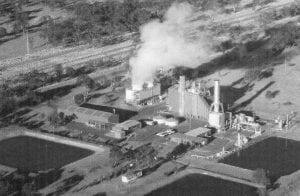
In the mid 2000s, the power focus in Barcaldine had shifted to solar power. A $70m project for a 75MW solar farm, built by Spanish company Elecnor, was sited just off the Capricorn Highway five kilometres east of the town, adjacent to major existing power infrastructure including the transmission substation and gas power station, all feeding power into the grid. It was built with $22.8m in funding from the Australian Renewable Energy Agency, and has more than 78,000 single axis tracking solar panels. The second stage – doubling the size of the project – was announced in April 2017, to be self-funded by Elecnor with the assistance of investors.
